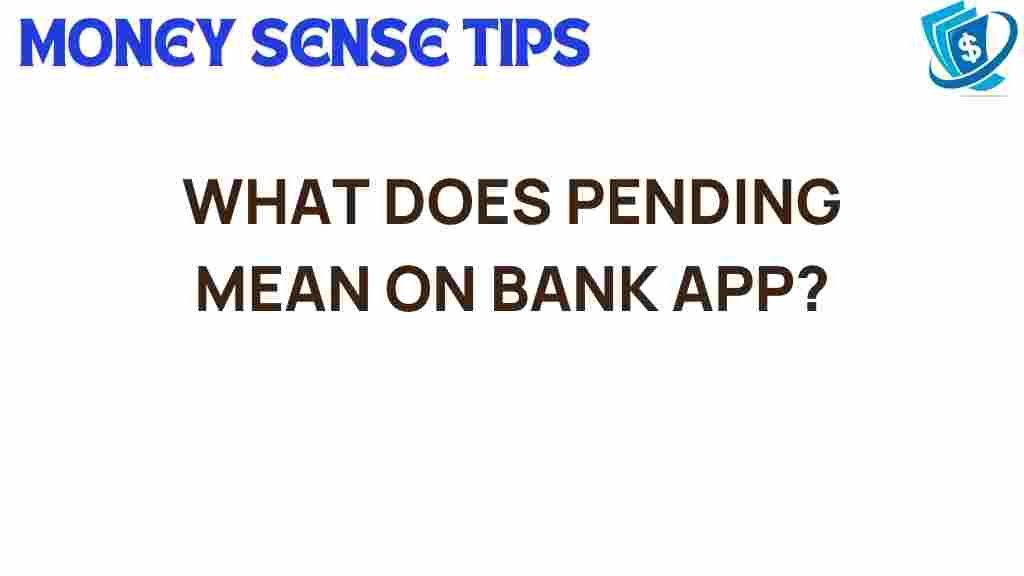Unraveling the Mystery: What Does “Pending” Mean on Your Bank App? Understanding Pending Transactions
In today’s fast-paced digital world, managing your finances through a bank app has become the norm. However, you may often find yourself puzzled by certain banking terminology, particularly the term “pending transactions.” Understanding what “pending” means in the context of your bank app is crucial for effective money management and tracking your transaction status. In this article, we’ll delve into the world of pending transactions, exploring their implications for your finances and enhancing your customer experience.
What Are Pending Transactions?
Pending transactions refer to purchases or withdrawals that have been authorized but have not yet cleared your account. This means that the transaction has been initiated, but the actual transfer of funds is still in process. Here’s a breakdown of how pending transactions work:
- Authorization: When you make a purchase, the merchant requests authorization from your bank. Your bank holds the funds temporarily, indicating that you’ve committed to spending that amount.
- Processing: After authorization, the transaction goes through processing, where the funds are transferred from your account to the merchant’s account.
- Clearing: Once processing is complete, the transaction is cleared, and the funds are officially deducted from your account.
Understanding the lifecycle of pending transactions is essential for effective finance management. It helps you maintain an accurate picture of your available balance and prevents overspending.
Why Are Pending Transactions Important?
Pending transactions play a significant role in your banking experience. Here are a few reasons why understanding them is essential:
- Budgeting: Knowing your pending transactions allows you to track your spending and manage your budget effectively.
- Fraud Detection: Monitoring pending transactions can help you quickly identify unauthorized charges, enhancing your security.
- Cash Flow Management: Understanding which transactions are pending helps you better manage your cash flow and plan for upcoming expenses.
How to Check Pending Transactions on Your Bank App
Checking pending transactions on your bank app is straightforward. Follow these steps for a seamless experience:
- Open Your Bank App: Launch the app on your smartphone or tablet.
- Log In: Enter your username and password to access your account.
- Navigate to Transactions: Locate the transactions or activity section in the app.
- View Pending Transactions: Look for a tab or section labeled “pending transactions” to see all your pending activities.
By familiarizing yourself with your bank app, you can quickly access important information about your finances.
Common Scenarios Involving Pending Transactions
Understanding various scenarios involving pending transactions can help demystify their presence in your bank app. Here are some common situations:
1. Online Purchases
When you shop online, the merchant may place a hold on your funds immediately after you confirm your order. This amount will appear as a pending transaction until the merchant processes your order and the funds are transferred.
2. ATM Withdrawals
When you withdraw cash from an ATM, the transaction may show as pending until your bank confirms and processes the withdrawal. This is especially common if you use an ATM operated by a different bank.
3. Restaurant Tips
At restaurants, when you pay your bill, the total amount may include a tip that hasn’t been officially processed yet. This can lead to a higher pending transaction amount than what you expect.
Troubleshooting Pending Transactions on Your Bank App
While pending transactions are generally easy to understand, you may encounter issues from time to time. Here are some troubleshooting tips:
1. Pending Transaction Not Showing
If a transaction you expect to see is not showing as pending:
- Check your internet connection to ensure your app is updated.
- Refresh the app or log out and log back in.
- If the issue persists, contact your bank’s customer service for assistance.
2. Incorrect Pending Amount
If the pending transaction amount seems incorrect:
- Review the transaction details to ensure you didn’t overlook any additional charges.
- Wait a few days, as the amount may adjust once the transaction clears.
- Reach out to the merchant or your bank if you suspect an error.
3. Long-Lasting Pending Transactions
Sometimes, a transaction may remain pending for an unusually long time:
- Verify with the merchant if they have processed the transaction.
- Contact your bank to inquire about the delay and possible resolutions.
Understanding the Duration of Pending Transactions
The duration of pending transactions can vary based on several factors:
- Merchant Processing Time: Different merchants have varying processing times, which affects how long a transaction stays pending.
- Bank Policies: Each bank has its policies regarding the duration of holds on pending transactions.
- Type of Transaction: Certain transactions, like international purchases, may take longer to process and clear.
Typically, pending transactions clear within a few days, but it’s important to check with your bank for their specific timelines.
Conclusion
Understanding pending transactions is vital for effective financial management and ensuring a smooth customer experience with your bank app. By grasping the meaning of “pending” and familiarizing yourself with the ins and outs of transaction status, you can take control of your finances and make informed decisions. Regularly monitoring your pending transactions not only helps in budgeting but also aids in fraud detection and cash flow management.
For more insights on managing your finances and understanding banking terminology, check out this comprehensive guide on digital banking that covers everything from budgeting tips to understanding your bank app. Remember, an informed customer is an empowered one!
By unraveling the mystery behind pending transactions, you can navigate your bank app with confidence, ultimately leading to better money management and a more rewarding banking experience.
This article is in the category Services and created by MoneySenseTips Team
